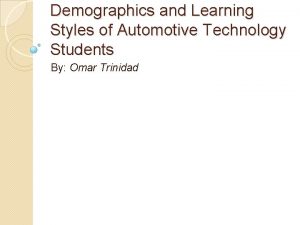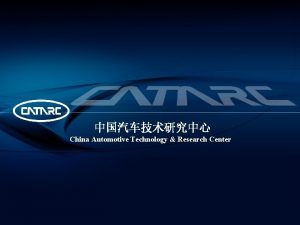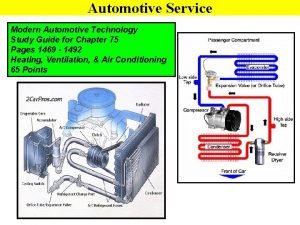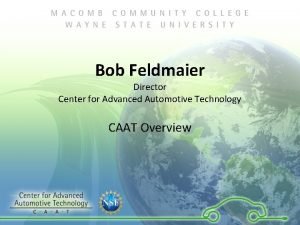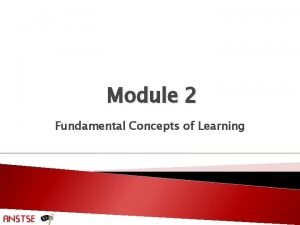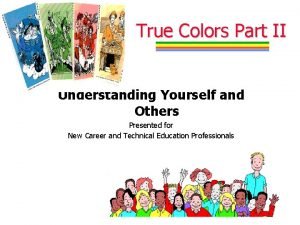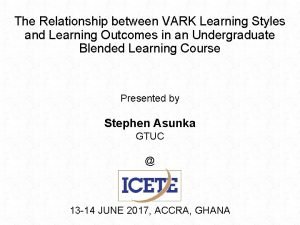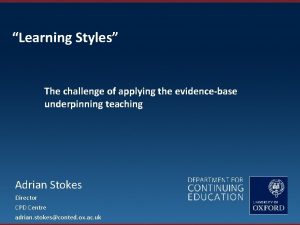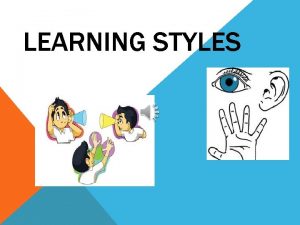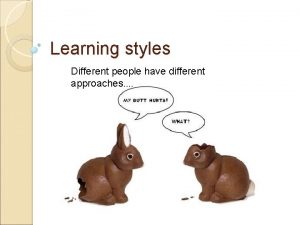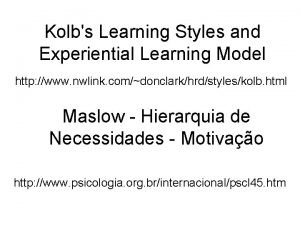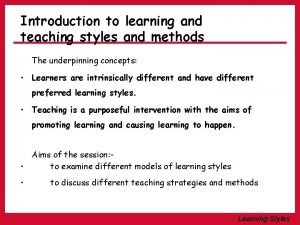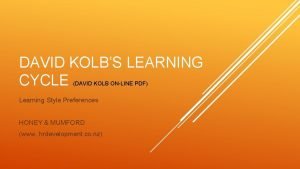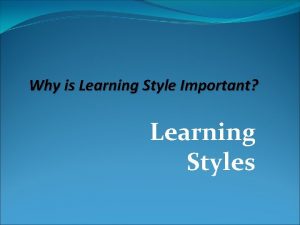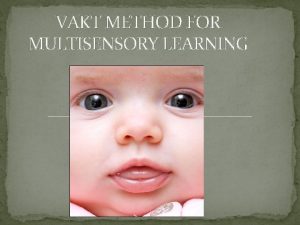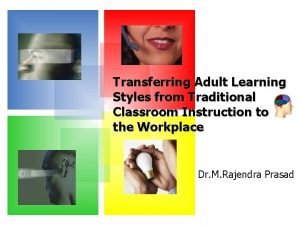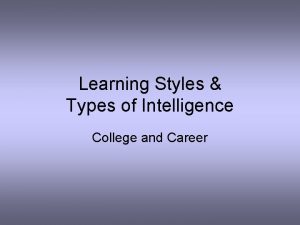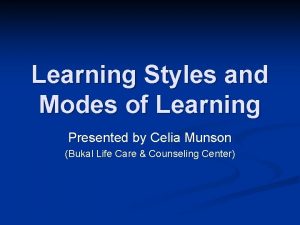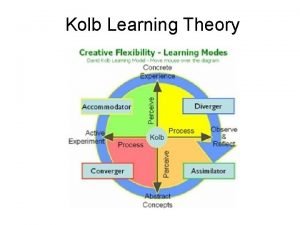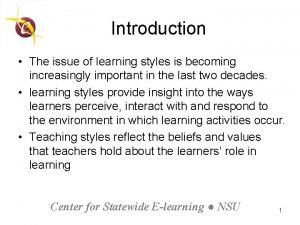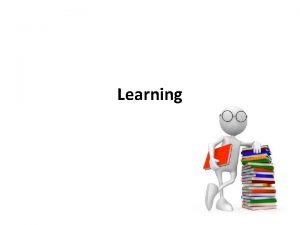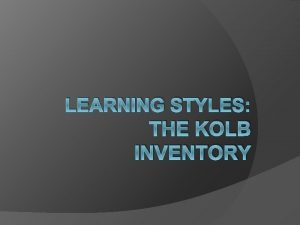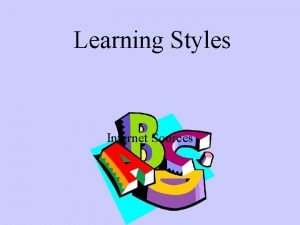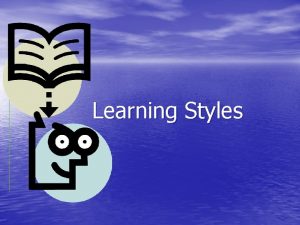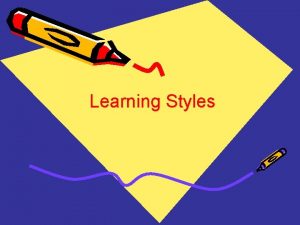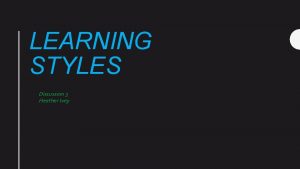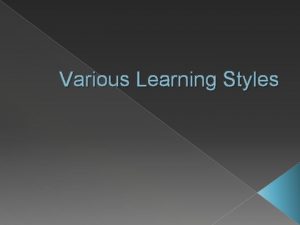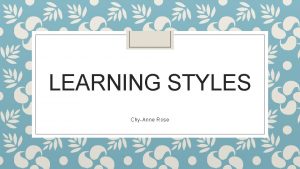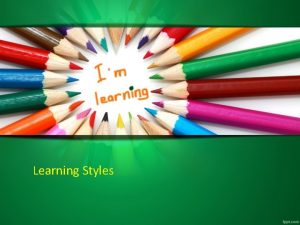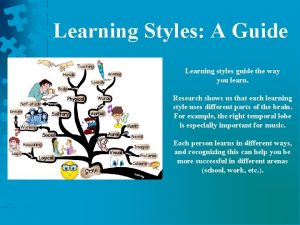Demographics and Learning Styles of Automotive Technology Students











































- Slides: 43

Demographics and Learning Styles of Automotive Technology Students By: Omar Trinidad

Overview Back Ground Purpose and Problem Statement Research Questions Literature Review Research Methods Analysis of Data Conclusions From the Study How to Teach Based on Learning Style

Background There is growth in the industry. ◦ The U. S Department of Labor Employment and Training Administration [U. S. DLETA] (2004) reported that the Automotive Industry “creates 6. 6 million direct and spin-off jobs and produces $243 billion in payroll compensation” (p. 1).

Background There is a need to understand Automotive Technology students. ◦ According to the U. S. DLETA (2004), “recruitment and retention of employees, education and training of current and potential employees, and promotion and image were all cited by executives as challenges that affect the ability to develop a world-class automotive workforce”(p. 3).

Background: Two programs Automotive Industry Planning Council ranked Southern Illinois University No. 1 in the nation ◦ 1993, 1999, and 2005 (Rosenbery, 2005). Ranken Technical College named Best in the State 8 times ◦ 2003 they were named Best in the Nation by the Automotive Industry Planning Council (Ranken Technical College, 2007).

Purpose The purpose of the study is to contribute to a better understanding of students who choose automotive technology careers. More specifically, the study attempted to identify the extent to which demographics influence the learning style of an automotive technology student.

Problem Statement There is a lack of information about the demographics and learning styles of automotive technology students in the world today. Gaining this information, and any relationships between the two variables, will help train and retain automotive technology students.

Research Questions What are the demographic characteristics of automotive technology students? 2. What are the learning styles of automotive technology students? 3. To what extent do demographics affect the learning style of an automotive technology student? 1.

Literature Review Demographics 1. 2. 3. 4. 5. 6. Ethnicity Gender Neighborhood GPA Disabilities Influence on Career Choice Learning styles Affects of Demographics on Learning Style

Literature Review: Demographics 1. 2. 3. Ethnicity ◦ Asian Americans are least likely to take Career and Technical Education classes. Gender ◦ According to Levesque (2003), “males took more vocational/technical [CTE] courses than females” (p. 14). Neighborhood ◦ Levesque (2003) wrote “student in rural schools took more vocational/technical courses than students in either urban or suburban schools” (p. 14).

Literature Review: Demographics 3. ◦ 4. ◦ GPA Students with lower GPAs generally completed more vocational credits (U. S DE NCES, 2000). Disabilities In a Cawley, Kahn, and Tedesco study (2001), findings revealed that “children defined as learning disabled participated in a large number of vocational trade specialties” (p. 1).

Literature Review: Demographics 5. ◦ ◦ Influence on Career Choice Most students choose their career out of their own interest. It seems like self-perception of competency plays a big role in career choice (Guay, 2005).

Literature Review: Learning styles CTE attracts students whose learning styles and other characteristics do not lend themselves to scoring well on high-stakes tests” (Elliot, 2007, p. 51). CTE Students “generally favor a hands-on learning method called kinesthetic learning style” (p. 44). Elliot and Deimler (2007),

Literature Review: Affects of Demographics on Learning Style 1. ◦ 2. ◦ Ethnicity Gong, Hu, & Lew, (1997) found no statistical difference in learning styles between Asian and Caucasian students. Gender According to Fleming (2007), men were found to prefer kinesthetic learning styles more than women, and women preferred read/write learning styles more than men.

Literature Review: Affects of Demographics on Learning Style 3. ◦ Age Fleming’s (2007) showed that as a person gets older he or she tends to lean towards one learning style instead of multiple learning styles.

Research Methods: Subjects SIUC: 133 ◦ 4 -year curriculum RTC: 165 ◦ 2 -year curriculum Total Participants: 298

Research Methods: Data Collection Instrument �Generic Demographic Survey ◦ age, gender, ethnicity, parent’s marital status, year in school, work experience, family socio-economic status, and influences on career choice. �VARK ◦ ◦ Visual Auditory Read/Write Kinesthetic

Research Methods: Procedures & Data Analysis Procedures ◦ Instructors facilitated the study ◦ Voluntary student participation ◦ 30 minutes Data Analysis ◦ SPSS ◦ Descriptive Statistics: Frequency ◦ Chi-Square Nominal Data

Analysis of Data Research Questions 1. What are the demographic characteristics of automotive technology students? 2. What are the learning styles of automotive technology students? 3. To what extent do demographics affect the learning style of an automotive technology student?

Research Question 1: Demographics Age 180 160 153 140 120 95 100 80 60 40 23 27 23 -24 25 and Above 20 0 18 -20 21 -22

Research Question 1: Demographics Gender 300 285 250 200 150 100 50 13 0 Male Female

Research Question 1: Demographics Ethnicity 300 251 250 200 150 100 50 0 18 9 4 3 African Asian Caucasian Hispanic Native American 13 Other

Research Question 1: Demographics Parents' Marital Status 200 186 180 160 140 120 100 80 67 60 38 40 20 3 0 Married Divorced Single Separated

Research Question 1: Demographics Year in School 140 120 116 100 89 80 55 60 36 40 20 0 Freshman Sophomore Junior Senior

Research Question 1: Demographics Years of Automotive Experience 120 100 96 80 68 68 65 1 year 2 year More than 3 years 60 40 20 0 Less than one year

Research Question 1: Demographics Highest Earning Parent's Annual Salary 132 140 120 100 80 50 60 40 16 20 35 33 26 Le bo 65 -A 5 K $6 $5 5 K -$ -$ 5 K $4 ve K K 55 K 45 5 K -$ -3 5 K $2 $3 ss th an $2 5 K 5 K 0

Research Question 1: Demographics Influnce for Studying Automotive Technology 300 239 250 200 150 100 41 50 0 4 6 2 Parental Movie Working with Easy Subject Took a High Hands school Shop Class

Research Question 1: Demographics Difference was found between schools ◦ SIUC had more Hispanics and Asian Americans ◦ RTC had more African Americans ◦ RTC had more students from a single parent

Research Question II: Learning Style 23 Learning Styles: 76. 6% (227) preferred a learning styles associated with Kinesthetic Learning Style

Research Question II: Learning Style Simplified Learning Styles for Both Schools 140 120 100 80 60 40 20 K R VA al Tr i. M od al M od Bi tic st ne Ki W rit d/ ea R he e l ra Au Vi su al 0

Research Question II: Affects of Demographics on Learning Styles � Some variables contained 0 frequencies. � The chi-square test of independence indicated that there was no statistical relationship between learning styles and: � Age, 2 (12, N = 295) = 16. 78, p =. 16 � Ethnicity: � Parents’ 2 (6, N = 296) = 12. 56, p =. 05 marital status: 2 (6, N = 292) = 7. 02, p =. 32 � Year in school: 2 (12, N = 294) = 15. 26, p =. 23 � Work experience: 2 (18, N = 295) = 14. 4, p =. 70 � Parent’s . 06 annual income: 2 (12, N = 290) = 20. 68, p =

Conclusions of the Study There significantly more males than females. There was a lack of Ethnical Diversity. Kinesthetic was most preferred. Visual was least preferred. There was no statistically significant relationship between demographic variables and learning style.

Learning Styles Visual Aural Read/Write Kinesthetic

How to Teach Visual Learners Pictures, posterns, slides, videos Flow chart Highlighting, underlining Symbols Graphs Textbooks with diagrams and pictures

How a Visual Learner Study Draw or use diagrams Write exam answers Recall the pictures Learn how to create Visual clue for Written Facts.

How to Teach Aural Learners Discuss the topics with others Discuss the topics with the instructor Try to explain the concepts to someone else Use a tape recorder and take note of what is understandable Leave spaces on the notes for future additions

How Aural Learners Study Imagine how one would explain the concepts Speak softly while reading Practice writing answers on old tests Speak answers inside your head

How to Teach Read/ Writer Learners Create lists Definitions Handouts Textbooks Notes Slides

How Read/Write Learners Study Write out the words Read your notes and rewrite if needed Organize diagrams and graphs into statements Write procedures for tasks Create multiple choices for answers

How to Teach a Kinesthetic Learner Use all their senses Increase lab times Use actions for concepts or principles Provide real-life examples Apply Hands-on approach with leadership Trial and error

How Kinesthetic Learners Study Practice procedures and formulas Use props to relearn principles Communicate with a fellow kinesthetic learner and discuss principles and concepts Try to take more lab time

Compensatory Strategies

Questions I have to Learn?
 Automotive demographics
Automotive demographics Automotive technology sixth edition
Automotive technology sixth edition China automotive technology & research center
China automotive technology & research center Modern automotive technology answer key
Modern automotive technology answer key Automotive technology sixth edition
Automotive technology sixth edition Emission control system components
Emission control system components Mechanical technology automotive grade 11
Mechanical technology automotive grade 11 Bob caat
Bob caat Rivet split pin
Rivet split pin 7 learning styles and vark similarities
7 learning styles and vark similarities Learning style
Learning style Learning styles and multiple intelligences
Learning styles and multiple intelligences Demographics and the demand for higher education
Demographics and the demand for higher education Forever 21 britney
Forever 21 britney Vicenta ybardolaza description
Vicenta ybardolaza description Cuadro comparativo de e-learning
Cuadro comparativo de e-learning Orange blue green gold personality test printable
Orange blue green gold personality test printable Define vark
Define vark Http://www.educationplanner.org
Http://www.educationplanner.org Objectives of learning styles
Objectives of learning styles Learning styles outline
Learning styles outline Gardner's 8 learning styles
Gardner's 8 learning styles Learning style auditory
Learning style auditory Education styles
Education styles Objectives of learning styles
Objectives of learning styles Kolbs learning styles
Kolbs learning styles Amiable expressive analytical driver
Amiable expressive analytical driver Why is knowing your learning style important
Why is knowing your learning style important Socioculturalismo
Socioculturalismo David kolb pdf
David kolb pdf Conclusion of learning styles
Conclusion of learning styles Vakt approach
Vakt approach Adult learning styles
Adult learning styles Learning styles for career development
Learning styles for career development Modes of learning
Modes of learning Kolb learning styles
Kolb learning styles Conclusion of learning styles
Conclusion of learning styles Male vs female learning styles
Male vs female learning styles Vark profile
Vark profile Walmart shopper profile
Walmart shopper profile Uf demographics
Uf demographics Population of bassetlaw
Population of bassetlaw Sfa demographics
Sfa demographics Causes of homelessness orange county
Causes of homelessness orange county
